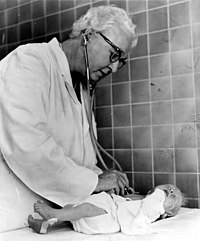
Photo from wikipedia
Objectives We aimed to evaluate (1) whether sedation analgesia (SA) used during therapeutic hypothermia (TH) was efficient to support the wellbeing of neonates with hypoxic-ischemic encephalopathy, (2) the SA level… Click to show full abstract
Objectives We aimed to evaluate (1) whether sedation analgesia (SA) used during therapeutic hypothermia (TH) was efficient to support the wellbeing of neonates with hypoxic-ischemic encephalopathy, (2) the SA level and its adjustment to clinical pain scores, and (3) the impact of inadequate SA on short-term neonatal outcomes evaluated at discharge. Methods This was an observational retrospective study performed between 2011 and 2018 in two level III centers in Alsace, France. We analyzed the wellbeing of infants by using the COMFORT-Behavior (COMFORT-B) clinical score and SA level during TH, according to which we classified infants into four groups: those with excess SA, adequate SA, lack of SA, and variability of SA. We analyzed the variations in doses of SA and their justification. We also determined the impact of inadequate SA on neonatal outcomes at discharge by multivariate analyses with multinomial regression, with adequate SA as the reference. Results A total of 110 patients were included, 89 from Strasbourg university hospital and 21 from Mulhouse hospital. The COMFORT-B score was assessed 95.5% of the time. Lack of SA was mainly found on the first day of TH (15/110, 14%). In all, 62 of 110 (57%) infants were in excess of SA over the entire duration of TH. Most dose variations were related to clinical pain scores. Inadequate SA was associated with negative short-term consequences. Infants with excess of SA had a longer duration of mechanical ventilation [mean ratio 1.46, 95% confidence interval (CI), 1.13–1.89, p = 0.005] and higher incidence of abnormal neurological examination at discharge (odds ratio 2.61, 95% CI, 1.10–6.18, p = 0.029) than infants with adequate SA. Discussion Adequate SA was not easy to achieve during TH. Close and regular monitoring of SA level may help achieve adequate SA. Excess of SA can be harmful for newborns with hypoxic-ischemic encephalopathy who are undergoing TH.
Journal Title: Frontiers in Pediatrics
Year Published: 2023
Link to full text (if available)
Share on Social Media: Sign Up to like & get
recommendations!